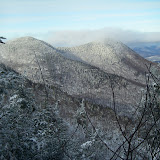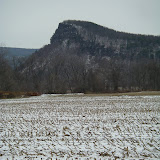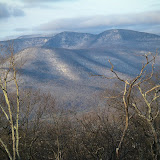 | |
| The Devils Path peaks from Balsam Cap |
There are many ways to get these four peaks. One very challenging hike I would love to try sometime in the future would be a big 17 mile loop from Neversink Valley, up the trail to Table Mountain, then traversing across the four trail-less peaks to Cornell, to complete the loop on the Wittenberg-Cornell-Slide, Curtis-Ormsbee, and East Branch trails. This would be an AWESOME seven peak day. If things were going well, it would be great to also add side trips to Peekamoose and, especially, Wittenberg for a twenty miler that might rival doing the Devils Path in a day, even though it would be fewer miles and less elevation gain. But I was not arrogant enough to think I could do this in the snow during the short days of Winter, solo, and with no familiarity of the off-trail sections. Actually, I was probably pushing things a little by starting the hike up Balsam Cap and Friday at noon, but that was the earliest I could get here and it was the last day I had with a good weather forecast. Besides, the round trip is only around seven miles - how hard could it be? Harder than anticipated, that’s how hard. I knew it would be steep, partly trail-less and thick, have nearly 3,000’ of cumulative elevation gain, route-finding issues, and snow to deal with. But I’m a reasonably strong and experienced hiker - surely I could do it in five hours, right? Wrong.
Given my late start, I had kind of hoped that there would be a group ahead of me to break trail, but no such luck. There was about a foot of fresh, untracked snow on the ground as I started up the steep woods road that eventually gains Friday’s eastern ridge. At first, it seemed quite powdery and easy, but after gaining a couple hundred feet in elevation it became obvious that I needed to stop and put on snowshoes. Things had just gotten slower. I was unfamiliar with the route, but a couple of times it seemed like the old road was going the wrong way, or too far out of the way, and I would simply head straight uphill and soon hit it or another road again. Eventually I wearied of sidehilling and guessing whether to stay on the road or not, so I just beelined it for the ridge crest and another road which I followed most of the way to the hunting cabin before I skirted left of the private inholding. Once around the cabin property and back on the ridgeline, I continued my upward tromp, eventually encountering vertical ledges. At this point, I started angling off the ridge and sidehilling upward toward the Balsam Cap-Friday col, at times on what appeared to be a path - though it was very indistinct and hard to be sure of since it was buried under 18-24” of untrammeled snow. At times, both on this sidehill traverse, and on steep slopes higher up on Friday, the firm snow would fracture several feet away from me as I stepped on it, letting out an audible “whoomf” and sliding down the hillside several feet or yards, occasionally taking me with it for a couple of feet. If I had been on an open slope, I think I might have even been a little worried about causing an avalanche. Here though, the trees pretty quickly stopped it. Regardless, in places I was essentially wallowing as drifted snow kept sliding out from under me. Progress slowed again.
Just beneath the col, I wandered back and forth a bit before finally finding a reasonable, though still not easy way through more ledges. No doubt I missed the preferred route, if there is one. I was happy to finally reach this gentle saddle and have most of the climbing behind me. But it had taken far longer than 2 ½ miles normally should. That was o.k. because I would surely make up for it now as I headed for Balsam Cap. Wrong again.
Now I got to deal with the thick balsams that these peaks are known for. While I didn’t think they were hideous, certainly nowhere nearly as bad as the worst I’ve been in, they were indeed dense and with their fair share of downfall to negotiate. I found no sign of a herd path as I forced a sinuous route southward. Several times on these two peaks my showshoes caught branches under the snow and tripped me up. Also, the spruce were plastered with snow and it was nearly impossible to get through them without knocking it off the low hanging boughs and dumping it on myself. It didn’t take long to get quite wet, especially since I didn’t want to shred my rain gear on the sharp branches and was only wearing a polypro top. While I had plenty of extra clothing, putting it on while in the spruce would have only gotten it wet too. This meant I needed to keep moving to stay warm. More slow going and some growing concern about the rapidly advancing time had another undesirable effect as well. It meant I couldn’t spare a lot of time searching for the canisters on the summits.
 |
| Ticeteneyck Mountain and Ashokan Reservoir from Balsam Cap |
 |
| The great view northeast from Balsam Cap. |
 |
| A snowy Cornell and Wittenberg from Balsam Cap |
 |
| Canister on Balsam Cap |
 |
| Formidable cliffs on Friday Mountain |
The descent from Friday was actually pretty easy excepting for one or two spots, and I was able to sort of glissade off several small ledges and steep sections with the snowshoes adding both flotation and braking. Escaping the col was even easier, and I made it across the sidehill traverse back to the east ridge in rapidly fading light. Following my own tracks, routefinding was no longer an issue, at least not until it got darker. I had stubbornly resisted stopping to get my headlamp out, but eventually my tracks became very difficult to see and I started worrying about getting a branch in the face or worse. I turned on the light about a mile from the end and suddenly my tracks were glaringly obvious, even more so than they had been while it was still light. I think I was able to actually go faster and made it back to the trailhead from the summit of Friday in just over 1 ½ hours compared to the 3 hours and 10 minutes it had taken me to get to Balsam Cap. The day hadn’t gone quite the way I would have liked it to have, but I was still pretty satisfied with it and the feeling that most of the remaining peaks for the Catskill 3500 will probably be easier - unless I try that big loop to get Lone and Rocky.
The route of my hike (not necessarily the best route) to Balsam Cap and Friday Mountain. To see a larger map click here.
Hike Stats:
7.4 miles
2,800' cumulative elevation gain
 |
| Balsam Cap & Friday Mountain, NY |
Resources:
gpx files and topos
Balsam Cap - Catskill 3500 Club
Friday Mountain - Catskill 3500 Club
Catskill Hiker
Catskill Mountaineer
Trailhead Coordinates:
41.98373,-74.32693
Google map for trailhead
Scan QR code to navigate to trailheads with Google Maps on your smartphone
:
























